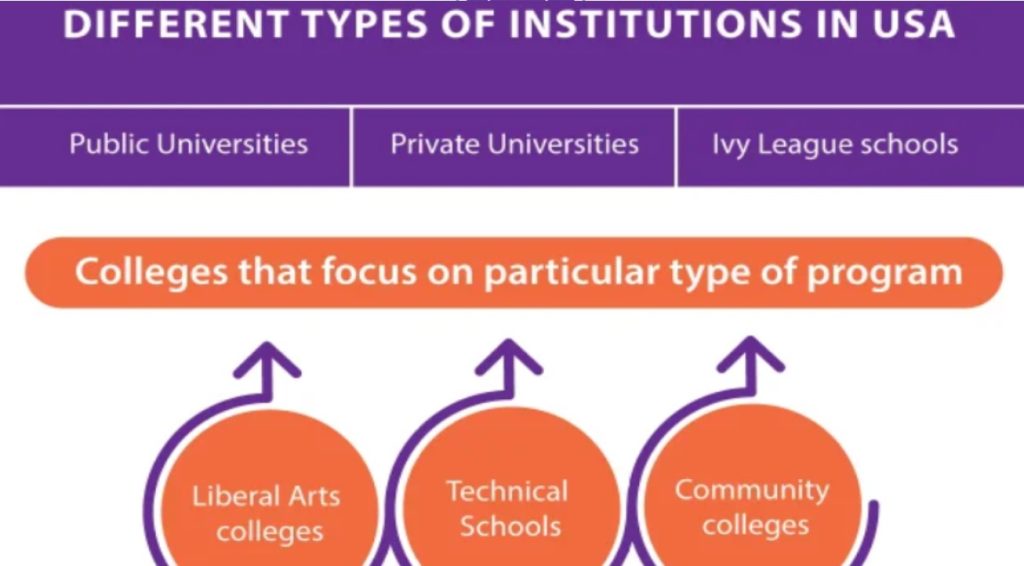Outline
- Introduction
- Overview of higher education in the USA
- Importance of choosing the right college
- Types of Colleges and Universities
- Community colleges
- Public universities
- Private colleges
- Liberal arts colleges
- Research universities
- Specialized institutions
- Admissions Process
- Overview of the application process
- Standardized testing (SAT/ACT)
- Application materials (essays, recommendations)
- Interviews and campus visits
- Financial aid and scholarships
- Academic Programs
- Undergraduate vs. graduate programs
- Popular majors and fields of study
- Online education and distance learning
- Campus Life
- Student organizations and extracurricular activities
- Diversity and inclusion
- Housing and dining options
- Mental health and wellness resources
- Career Services and Alumni Network
- Importance of career services
- Internship and job placement support
- Alumni networks and connections
- Challenges in Higher Education
- Cost of attendance
- Student debt crisis
- Balancing academics and personal life
- Future Trends in Higher Education
- Rise of online education
- Changes in enrollment demographics
- Increasing importance of skills-based education
- Conclusion
- Recap of the key points
- Encouragement to research and choose wisely
1. Introduction
Overview of Higher Education in the USA
Higher education in the United States is diverse and complex, comprising thousands of institutions that offer a wide range of academic programs and experiences. With over 4,000 degree-granting colleges and universities, students have numerous options when it comes to choosing where to pursue their education. The U.S. education system is known for its flexibility and emphasis on liberal arts education, encouraging critical thinking and a well-rounded curriculum.
Importance of Choosing the Right College
Selecting the right college is a pivotal decision that can influence a student’s academic journey, career prospects, and personal growth. Factors such as location, size, academic offerings, campus culture, and financial considerations play significant roles in this decision-making process.
2. Types of Colleges and Universities
Community Colleges
Community colleges are two-year institutions that offer associate degrees, certificates, and vocational training. They are often more affordable and provide flexible schedules, making them a great option for students looking to enter the workforce quickly or transfer to a four-year institution later on. Many community colleges have partnerships with local universities to facilitate transfer pathways.
Public Universities
Public universities are funded by state governments and typically offer lower tuition rates for in-state residents. These institutions often have large student populations and a wide variety of academic programs. Notable examples include the University of California system, the State University of New York (SUNY) system, and the University of Florida.
Private Colleges
Private colleges are independently funded and may have higher tuition rates compared to public universities. However, they often provide smaller class sizes, more personalized attention, and unique programs. Institutions like Harvard University, Stanford University, and the University of Chicago are among the most prestigious private colleges in the U.S.
Liberal Arts Colleges
Liberal arts colleges focus on providing a broad education in the humanities, social sciences, and natural sciences. They emphasize critical thinking, communication, and analytical skills. Institutions such as Williams College, Amherst College, and Swarthmore College are known for their strong liberal arts programs.
Research Universities
Research universities are large institutions that prioritize research and offer a wide array of graduate and professional programs. These universities often have extensive facilities and resources for conducting research. Examples include Johns Hopkins University, Massachusetts Institute of Technology (MIT), and Stanford University.
Specialized Institutions
There are also specialized colleges that focus on specific fields, such as engineering, business, arts, and health sciences. For instance, the Juilliard School is renowned for its performing arts programs, while the Georgia Institute of Technology is well-known for its engineering and technology programs.
3. Admissions Process
Overview of the Application Process
The admissions process for colleges in the U.S. can vary significantly from one institution to another, but generally involves submitting an application form, standardized test scores, transcripts, letters of recommendation, and personal essays.
Standardized Testing (SAT/ACT)
Many colleges require standardized test scores from the SAT or ACT as part of the application. These tests assess a student’s readiness for college and can influence admissions decisions. However, a growing number of institutions are adopting test-optional policies, allowing students to decide whether to submit test scores.
Application Materials (Essays, Recommendations)
Personal essays provide students with an opportunity to showcase their personality, experiences, and aspirations. Letters of recommendation from teachers or mentors also play a crucial role in presenting a student’s character and academic capabilities.
Interviews and Campus Visits
Some colleges may require or offer interviews as part of the admissions process. Campus visits can also provide valuable insights into the campus culture and help students gauge whether a school is a good fit for them.
Financial Aid and Scholarships
Financial aid is an essential consideration for many students. The Free Application for Federal Student Aid (FAFSA) is used to determine eligibility for federal financial aid, and many colleges offer their own scholarships based on merit, need, or specific criteria.
4. Academic Programs
Undergraduate vs. Graduate Programs
Undergraduate programs typically culminate in a bachelor’s degree and focus on a broad education, while graduate programs offer advanced studies, leading to master’s or doctoral degrees. Many colleges encourage undergraduate students to participate in research or internships to gain practical experience.
Popular Majors and Fields of Study
Some of the most popular majors in U.S. colleges include business administration, psychology, biology, computer science, and engineering. However, students are increasingly exploring interdisciplinary studies and emerging fields such as data science, environmental studies, and digital marketing.
Online Education and Distance Learning
The rise of online education has transformed how students access learning opportunities. Many colleges offer fully online programs or hybrid models that combine in-person and online courses. This flexibility allows students to balance their studies with work or personal commitments.
5. Campus Life
Student Organizations and Extracurricular Activities
Campus life plays a vital role in the college experience. Most colleges have a variety of student organizations, clubs, and extracurricular activities that cater to diverse interests. These can range from academic clubs to cultural organizations, sports teams, and volunteer groups.
Diversity and Inclusion
Colleges in the U.S. are increasingly prioritizing diversity and inclusion initiatives. Many institutions strive to create welcoming environments for students of all backgrounds, promoting multiculturalism and fostering discussions around equity and social justice.
Housing and Dining Options
On-campus housing options vary, including dormitories, apartments, and themed living communities. Dining services also offer a range of choices, from traditional meal plans to various dietary accommodations, including vegetarian and vegan options.
Mental Health and Wellness Resources
Mental health support is a growing focus for many colleges. Resources may include counseling services, wellness programs, and workshops aimed at promoting mental well-being among students.
6. Career Services and Alumni Network
Importance of Career Services
Most colleges offer career services to assist students in finding internships and job placements. These services may include resume workshops, career fairs, and networking events that connect students with potential employers.
Internship and Job Placement Support
Internships are critical for gaining real-world experience and enhancing employability. Colleges often have partnerships with local businesses and organizations to provide students with internship opportunities.
Alumni Networks and Connections
A strong alumni network can significantly benefit current students. Alumni often provide mentorship, job leads, and networking opportunities, helping graduates navigate their career paths.
7. Challenges in Higher Education
Cost of Attendance
The cost of attending college in the U.S. has been a growing concern. Tuition rates have increased significantly over the years, leading many students to incur substantial debt. Understanding the total cost of attendance—including tuition, fees, housing, and textbooks—is essential for prospective students.
Student Debt Crisis
The student debt crisis poses challenges for many graduates as they navigate repayment while beginning their careers. Discussions around student debt forgiveness and policy reforms are ongoing, highlighting the need for sustainable solutions.
Balancing Academics and Personal Life
Managing academics, extracurricular activities, and personal life can be overwhelming for students. Time management and prioritization skills are crucial for maintaining a healthy balance and ensuring academic success.
8. Future Trends in Higher Education
Rise of Online Education
The COVID-19 pandemic accelerated the growth of online education, with many institutions adopting remote learning models. As technology continues to evolve, online education may become even more integrated into traditional educational frameworks.
Changes in Enrollment Demographics
Demographics of college students are shifting, with increasing diversity in age, ethnicity, and background. Institutions are adapting to meet the needs of a broader range of students, including adult learners and non-traditional students.
Increasing Importance of Skills-Based Education
Employers are placing greater emphasis on skills over degrees. As a result, colleges are incorporating more hands-on learning, internships, and industry partnerships into their programs to better prepare students for the workforce.
9. Conclusion
In conclusion, the landscape of colleges and universities in the USA is diverse and continually evolving. From understanding the different types of institutions to navigating the admissions process and campus life, students have numerous factors to consider. By researching and reflecting on personal goals and preferences, prospective students can make informed decisions that shape their educational journeys and future careers.


